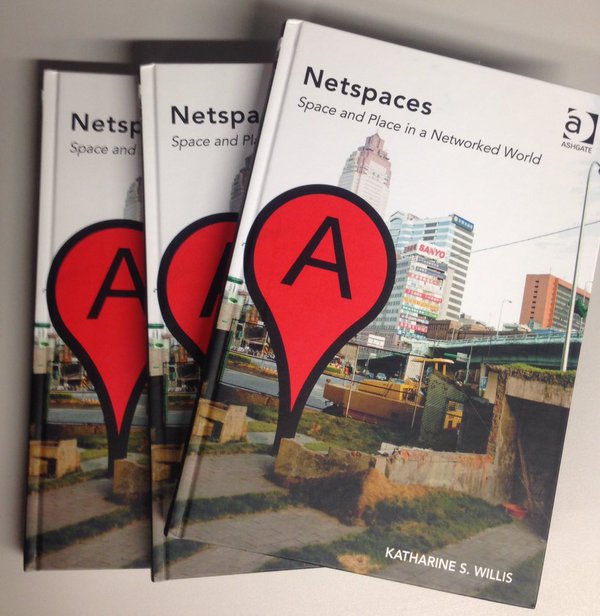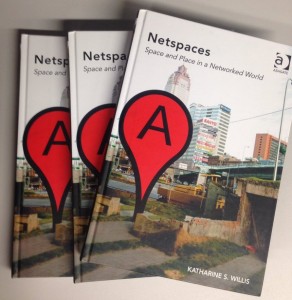BY KATHARINE S. WILLIS
The approach and focus of my book, Netspaces, published last year, is on understanding and explaining the way that our increasingly networked world impacts on the legibility of cities; that is, how we experience and inhabit urban space. It reflects on the nature of the spatial effects of the networked and mediated world – from mobile phones and satnavs to data centres and Wi-Fi nodes – and discusses how these change the very nature of urban space.
One of the key challenges in addressing the way that technologies affect our experience of the built world is that they fail to conform to traditional notions of the spatial; the sensed, the embodied and the material. In order to uncover a spatiality of the network that was not ‘placeless,’ it was Doreen Massey’s writing that enabled, for me, an unlocking of what ‘place(s)’ of technology might mean.
This is a concept I termed ‘netspaces’: the spaces that emerge at the interchange between the built world and the space of the network.
Massey’s reading of space and place revealed an experience that moves beyond the individual and the sensed to a weaving of experiential trajectories that allow for the existence of multiplicity. This opened up for me a way of working with space and place that permits technological experience to be part of what Massey terms ‘the event of place’: ‘that thrown-togetherness, the unavoidable challenge of negotiating the here-and-now; and a negotiation which must take place within and between the human and non-human… this is the event of place’ (For Space, 2005).
If we shift our thinking from a view of place as distinct and bounded location that has meaning through the relationship we construct with it over time, to the idea of place as socially constructed and part of contingent situations and trajectories, this does not mean that places do not still provide meaning in our lives. Places, as part of contingent situations, are created when social practices and technological actors mutually constitute meaningful interactions.
Massey gives value to the ‘places in between’. In these space she argues that you are ‘travelling not across space-as-a-surface…you are travelling across trajectories’. Places becomes part of trajectories that are co-ordinated before, during and after through social networks, such as Twitter, Facebook and WhatsApp.
In their study of Japanese teenagers, Ito and Okabe (2005) note that ‘people saw value in residing for a period of time in a desirable location. Just as people seek out beautiful campsites to set out there gear and reside for short periods of time, urbanites find attractive public places to temporarily set up camp with the help of their information technologies’. They term this the ‘colonisation of inbetween space’.
Cafés are good examples of inbetween spaces, where people set up camp, creating a fluid mix of workspace, meeting space and food space. Paradoxically this means that these spaces then start to become less fluid and more stable.
Certain characteristics make cafés attractive as places for ‘camping’; the presence of other people and the atmosphere of a comfortable ‘home-away-from-home’. In their ethnographic study of the everyday lives of young urban professionals, Ito, Okabe and Anderson (2010) found that ‘the attraction of working in a specific “camping site” can include the personal relationships fostered there, food and drink, infrastructures (tables, electricity, Wi-Fi), and most importantly, diffuse social ambience’. These places require a hybrid of physical ‘affordances’ (such as a place to sit) and technical properties; inhabiting the place inbetween means having access to power and Wi-Fi.
The flows of information and exchange of networked interactions alter the character and function of space over time. These information flows, social exchanges and encounters become part of the material of the city, just as the height of buildings, the location of parks and the thoroughfares of key streets. But since information flows are ephemeral, there is a need to make sense of them just as we make sense of the city through our eyes.
These networked places gain materiality not through the senses but through our attention, which has an impact on the experience of place and also on the nature of urban legibility. We become present and aware of these places as we choose to focus our attention on a mobile screen or a phone call or a text message. This is a phenomenon I characterise as ‘selfie’ architecture.
For this moment we participate actively in a place that shapes how we decide what to do and makes connections with other places, whether near or far. Remarkable or distinctive places are not realized at unique locations but as events, played out over time and encompassing multiple locations.
This privileges inbetween spaces, everyday and often overlooked spaces of transit and social encounters. The experience of digital places evades some of the more formal ways in which we have come to make sense of the physical world around us, but in doing so they open up opportunities for a more situated and socially constructed sense of place.

About the author:
Dr Katharine Willis is Associate Professor (Reader) in Architecture and Co-ordinator of the Culture, Theory and Space Research Cluster at Plymouth University. She is the Principal Investigator on the Sustainable Digital Neighbourhoods Research Project. She is the author of Netspaces: Space and Place in a Networked World (Routledge 2015) and co-editor of Shared Encounters (Springer 2010)


